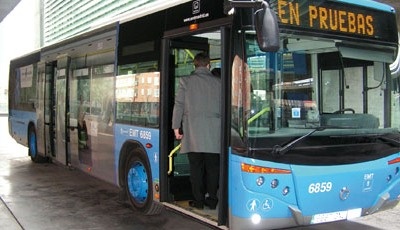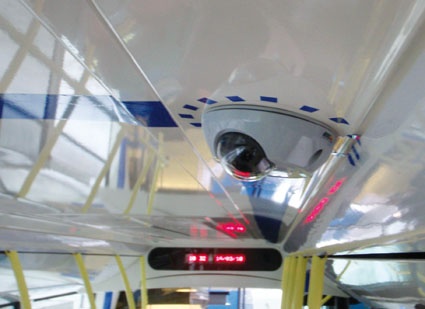Transport Surveillance Is Rapidly Changing
Axis Communications has been very succesful with public transportation projects and offers products specifically designed for this sector. Patrik Anderson, Director of Business Dev...



Axis Communications has been very succesful with public transportation projects and offers products specifically designed for this sector. Patrik Anderson, Director of Business Development, Transportation for Axis Communications, talks to GIT-SECURITY.com to reveal how public transport surveillance is changing, and what security managers can do in order to future proof their systems.
GIT-SECURITY.com: What is the first thing that comes to mind when you hear "Public Transportation Security"?
P. Anderson: I would actually say that it is three things: Protecting passengers, personnel and assets. Caring for passengers' safety during their complete travel; from the very start of the journey until the final stop and exit out of the public transport system. Protecting the personnel during their complete work shift, during day and at night. For the assets; regardless of location at stations, depots, along the infrastructure and rolling stock.
What are the main reasons for needing to install surveillance?
P. Anderson: Public transport systems today, both in urban locations as well as nationwide, cover very big security domains. The number of locations, vehicles and length of infrastructure are diverse and disperse.The multitudes of security related events that occur originate not only from the volume of passengers but are also a mirror of society's issues & problems. Surveillance systems serve as the instrumental tool for security operators to be able to assess the situation at hand and make a decision remotely on what to do for each specific case. The ability to connect the right response to the right incident is the role of the surveillance system at its essence. There is a big difference between handling violence or vandalism at a station, managing a response to pick pocketing or other disorderly behavior on board a bus or metro and intercepting metal theft taking place on the rail infrastructure or detecting and preventing graffiti before it takes places at the depot. Surveillance systems are great at capturing these types of events, being the prolonged eyes.
What are the challenges in creating a safe and secure transportation environment?
P. Anderson: The vast number of people using public transport makes it more difficult to monitor than say, airports. Add to this the high number of entrances and exits on trains, tubes, buses, depots and stations, and designing an installation becomes tricky. For example, there are some 9 million people using the Moscow metro daily. Within it there are 173 stations spread out across twelve lines with a total length of 801km of track and 4428 rail coaches in use on an average day. Now that's a lot of ground to cover!
In what way can IP-based surveillance solutions help to improve the security in public transit systems?
P. Anderson: IP can greatly improve surveillance capabilities by using open interfaces which are based on open standards and protocols. Even the camera architecture is, in Axis' case, an open platform on which to execute embedded & intelligent software which analyzes the video stream and aids security operators with whatever is going on in their environment. When using traditional analog cameras, transport staff is able to investigate incidents which occur. However, when using IP surveillance to its true potential, staff can better detect and receive alerts for incidents in the very early stages of their development to help predict further activity. This is effectively like switching from reactive surveillance, where staff can respond to a situation they see occurring, to active surveillance, whereby staff can predict a situation and act to prevent it totally or minimize its full potential.
What might the future hold for transportation surveillance?
P. Anderson: In the near future we're going to be seeing a lot more IP based solutions. This will make it possible to easily connect various security systems to one another into larger systems and enable real time gathering and sharing of video information. We'll also start to see more solutions that are based on built in-camera intelligence (video analytics) as this technology matures. For example, automatic alerts when an object is blocking or crossing a railroad or rail track, or a motion detection sensor which alerts authorized personnel to the existence of trespassers on tracks, at stations and level crossings of the infrastructure. The proliferation of HDTV video quality will continue which allows for easy identification, facilitates investigations and compared to analog footage can be used more readily as valid evidence in a court of law. Furthermore, the high image resolution of HDTV video streams enables surveillance system designers to use fewer cameras to cover the same surveillance domain compared to analog cameras. The face of transport surveillance is rapidly changing and an IP based system is the best way to ensure your surveillance system is future proof.
Axis transportation solutions
Axis Communications has a broad product portfolio specifically for the public transport sector. It offers IP surveillance solutions for use onboard vehicles, at stations & depots and along the infrastructure. All cameras hold the necessary transportation certificates and are rugged so to withstand the demanding conditions and environment they are placed in. They adhere to formal public transport sector regulations.
The network cameras in the Axis M31-R Series, which are designed specifically for being onboard vehicles, have a flat and discreet design with no sharp edges for passenger safety. They have an IP67 rating with an integrated dehumidifier and operate across a broad temperature range. They include intelligence such as active tampering alarms for detecting attempts such as blocking or spray-painting,-and video motion detection.
Axis also has a wide range of outdoor and vandal resistant offerings for stations, depots and infrastructure. For detection at night, in tunnels and low light conditions, Axis offers thermal imaging in the Axis Q19 Series.
Proven Large-scale Projects
Some references where Axis transportation solutions is being used:
- Stockholm metro and buses (Sweden):
- More than 15,000 cameras
- Sydney's new suburban trains (Australia): 7,000 cameras
- Madrid buses (Spain): 6,000 cameras
- SBB commuter trains in Zürich (Switzerland): 5,000 cameras
- Moscow metro, stations and subway trains (Russia): 3,000 cameras and video encoders
Business Partner
Axis Communications ABGränden 1
223 69 Lund
Sweden
most read

When the Internet stumbles: Why DNS is important
When DNS fails, the internet stumbles-AWS outage proves resilience and redundancy are vital for digital trust

Machine & plant safety: The winners of category A at the GIT SECURITY AWARD 2026
GIT SECURITY AWARD 2026: Machine & plant safety - an overview of the most innovative solutions

Is Your Venue Ready for Martyn’s Law?
Martyn’s Law demands stronger security by 2027. Is your venue prepared to protect and respond?

Integrated and Futureproof: Traka’s Next Chapter
Interview with Stefni Oliver on Traka’s Vision for the Future

Assa Abloy's battery-powered Aperio KL100 secures lockers
Boost workplace security and operational flexibility by securing more than just doors.






